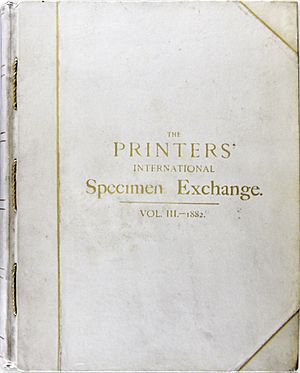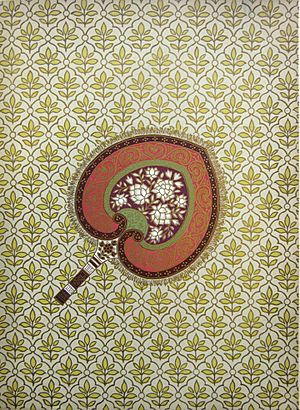Printers' International Specimen Exchange facts for kids
Quick facts for kids
|
|
|---|---|

Cover of Vol. III
|
The Printers' International Specimen Exchange was a special yearly book published from 1880 to 1898. It was very important for helping printers learn new skills. This project started around the time of the Caxton Celebration in 1877. It grew from a section called "Specimens" in a popular magazine, the Paper & Printing Trades Journal. This magazine was made by Field & Tuer, printers and publishers in London. Andrew White Tuer was its editor.
Contents
What Was the Specimen Exchange?
The idea for the Exchange came from a letter in 1879. Thomas Hailing, from Oxford Printing Works, wrote to Andrew Tuer. Tuer said his company would help if 100 printers joined.
How Printers Participated
Printers, their workers, and even apprentices could send in examples of their best printed work. They sent enough copies for everyone who subscribed that year. In return, they received a full book with all the accepted samples from other printers.
Cost and Binding
Joining the Exchange cost one shilling. For people in America, it cost three shillings. If you paid a bit more, your finished book came in a fancy cover. This cover was made of half vellum, a type of treated animal skin, and tied with catgut.
Growth and Popularity
Many more printers wanted to join the first issue than expected. So, the book quickly changed from being published twice a year to once a year.
Famous Supporters
John Ruskin, a famous writer, praised the project's goals. His letter was even included in the first book. Queen Victoria herself accepted a copy of Volume VI. This showed how important the Exchange was.
International Reach
At first, most of the printed samples came from Great Britain and the United States. But by the mid-1880s, the Exchange had grown a lot. It included about 400 samples from all over the world.
Changes in Editing
For the first three years, Tuer and his helper, Robert Hilton, wrote comments about each sample. Their comments were honest and often funny. But as more people joined from different countries, it became too much work. Also, giving detailed reviews might have caused problems with international printers.
Publishers and Printing Styles
Volumes I to VIII (from 1880 to 1887) were published by Field & Tuer. Their company was called the Leadenhall Press in London. These early books showed both old-fashioned and new "Artistic" printing styles.
Decline and End
After Volume VIII, Tuer gave the publishing job to Robert Hilton. Hilton had become the editor of a new magazine, the British Printer. This magazine was published by Raithby & Lawrence.
The Exchange's Decline
The Exchange started to become less popular under Hilton's leadership. It began to focus too much on a new printing style called "Leicester Free Style." This style was created by Robert Grayson, a foreman at Raithby & Lawrence.
The Final Years
The project ended a few years after Raithby & Lawrence sued Hilton. They said he broke an agreement not to start a competing publication. The last two books were much thinner and each covered two years. The very last one came out in early 1898. It had only 123 printed samples.
Lasting Impact
Even though it ended, the Printers' International Specimen Exchange was very important. It taught many printers how to study and learn from printed work. It also inspired similar projects in Germany, France, and the United States.


